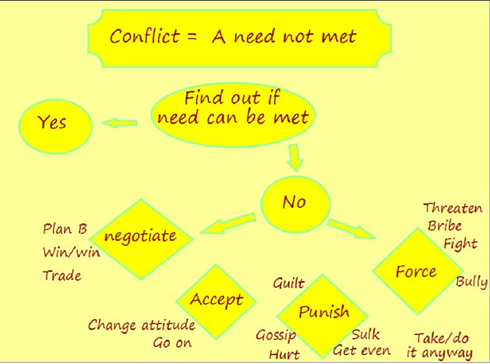
Conflict: Everybody’s Got It Conflict Management & Resolution People Management Uncategorized
Conflict with someone is never fun. Think about the last conflict you had. Do you remember what it was about? I mean, really about? I say that because often we have conflict and do not even realize the root of the issue.
Today I’d like to dive into the topic of conflict by examining:
- The real sources of conflict
- Positive and negative strategies to deal with conflict
Conflict is the result of a need not met. This is where we start, my friend. Identify the need not met. It may not be obvious or clear, which muddies the attempt at resolving the issue.
For example, a teenager and mother may be arguing over the teen’s choice of clothing, hair, and make up. What are the needs not being met? Perhaps the mother is upset her daughter is not sharing her same values in appearance. Or perhaps she fears her friends will judge her parenting ability if they see her daughter. Or perhaps she truly just enjoys micromanaging her daughter. It could be a lot of reasons!
What IS clear, however, is that there needs to be communication on both sides stating what needs are not being met so they have solid ground to work from.
Below is a list of the most common sources of conflict:
- Territory
- Property
- Values and Beliefs
- Power and Authority
- Money
- Rewards
- Trust
Now think back to that last conflict you had again. What was the source? What need was not met on both sides?
After identifying the source and need not met, the question becomes, “Can we meet our needs?” If the answer is yes, problem solved! If the answer is no, you both now have a decision to make.
How will you respond and move forward? The chart below maps out four common responses; two are positive, and two are negative.

Two possible responses on the left are positive:
- Negotiate > come up with a Plan B, a win/win, or take turns or trade.
- Accept that you will not get your way > requires changing your attitude and moving on.
The other two possible responses are negative and not recommended:
- Punish > guilt, gossip, hurt feelings, sulk, get even, silent treatment, mind games.
- Force > take it or do it anyway, threaten, bully, fight, bribe, intimidate.
To move forward, keep these tips in mind:
- Target the issue: identify the real need and stick to the topic.
- Tackle the issue: choose a positive strategy and go from there.
- Time the discussion well: choose a good time, when both are calm.
- Talk things through: Calmly, rationally, talk in adult language. Listen carefully.
- Trade places with the other person: See things from their point of view.
Conflict is not something to be avoided out of fear, my friend. You will feel peace once it is resolved in a positive way.
-Jan Jones
For more on conflict resolution, check out this video: